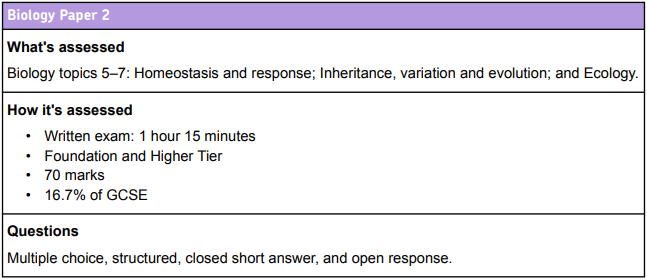Mock test. 70 marks available.
GCSE AQA Combined Science Trilogy Biology Paper 2
Good Luck!
Quiz Summary
0 of 32 Questions completed
Questions:
Information
You have already completed the quiz before. Hence you can not start it again.
Quiz is loading…
You must sign in or sign up to start the quiz.
You must first complete the following:
Results
Results
0 of 32 Questions answered correctly
Your time:
Time has elapsed
You have reached 0 of 0 point(s), (0)
Earned Point(s): 0 of 0, (0)
0 Essay(s) Pending (Possible Point(s): 0)
| Average score |
|
| Your score |
|
Categories
- Not categorized 0%
- 6 Mark Questions 0%
- Short Answer 0%
- 1
- 2
- 3
- 4
- 5
- 6
- 7
- 8
- 9
- 10
- 11
- 12
- 13
- 14
- 15
- 16
- 17
- 18
- 19
- 20
- 21
- 22
- 23
- 24
- 25
- 26
- 27
- 28
- 29
- 30
- 31
- 32
- Current
- Review
- Answered
- Correct
- Incorrect
-
Question 1 of 32
1. Question
2 point(s)[question number = 01.1] Use some of the following words to fill in the blanks:
Gene, allele, sugar, oxide, phosphate-
The complimentary base pairs that join strands of DNA together are attached at either end to a and each of those is attached to a group.
CorrectIncorrect -
-
Question 2 of 32
2. Question
2 point(s)[question number = 01.2] Drag and drop to match the base pairs in DNA
Sort elements
- T
- G
- A
- C
CorrectIncorrect -
Question 3 of 32
3. Question
3 point(s)(short answer) [question number = 01.3] What is a gene and what is its primary function
Correct 3 / 3 PointsIncorrect / 3 Points -
Question 4 of 32
4. Question
1 point(s)[question number = 01.4] Which term do we use to describe the entire DNA of an individual?
CorrectIncorrect -
Question 5 of 32
5. Question
2 point(s)[question number = 02.1] Drag and drop to match the role and structure
Sort elements
- Physical characteristics of an organism
- The alleles an organism has
- Phenotype
- Genotype
CorrectIncorrect -
Question 6 of 32
6. Question
1 point(s)[question number = 02.2] Choose the correct set of sex chromosomes to fill in this genetic diagram (genetic cross).
 CorrectIncorrect
CorrectIncorrect -
Question 7 of 32
7. Question
4 point(s)(short answer) [question number = 02.3] Selective breeding has been used in the past to change the behaviour of domestic animals such as dogs. A farmer is having persistent issues with goats escaping from their pens. Goats are very good at escaping because they can climb and jump over fences. A farmer decides that enough is enough and they will selectively breed the goats to change their behaviour. Describe the process the farmer should carry out in order to change the behaviour of the goats using selective breeding.
Correct 4 / 4 PointsIncorrect / 4 Points -
Question 8 of 32
8. Question
3 point(s)[question number = 02.4] Put the following steps in order to describe how genetic engineering of bacteria can be carried out to produce insulin.
- The plasmids are inserted back into bacteria where they can make insulin and it can be harvested
- Restriction enzymes are also used to cut open bacterial plasmids, this created sticky ends with complimentary bases
- Insulin producing genes are inserted into the plasmids and ligase is used to join the sticky ends
- Restriction enzymes are used to cut DNA molecules (insulin genes from human chromosomes) producing sections with unpaired bases at each end (sticky ends)
View Answers:
CorrectIncorrect -
-
Question 9 of 32
9. Question
1 point(s)[question number = 02.5] Which of the following is a risk of genetic engineering of crops?
CorrectIncorrect -
Question 10 of 32
10. Question
1 point(s)[question number = 03.1] Which modern development led to the suggestion of the Three-Domain System?
CorrectIncorrect -
Question 11 of 32
11. Question
3 point(s)[question number = 03.2] What are the three domains? (short answer)
Correct 3 / 3 PointsIncorrect / 3 Points -
Question 12 of 32
12. Question
1 point(s)[question number = 03.3] Evidence for Darwin’s Theory of Evolution was found when resistance to what emerged in some species of bacteria? (short answer)
CorrectIncorrect -
Question 13 of 32
13. Question
4 point(s)[question number = 03.4] What groups of organisms are eukaryotes?
Correct 4 / 4 PointsIncorrect / 4 Points -
Question 14 of 32
14. Question
1 point(s)[question number = 04.1] What term do we use to describe the release of an egg from the ovary? (short answer)
CorrectIncorrect -
Question 15 of 32
15. Question
4 point(s)(short answer) [question number = 04.2] Describe how hormones control the menstrual cycle
Correct 4 / 4 PointsIncorrect / 4 Points -
Question 16 of 32
16. Question
1 point(s)[question number = 04.3] Blood glucose levels are controlled with insulin and glucagon to maintain suitable levels of blood glucose concentration. What type of feedback mechanism is this?
-
feedback, since a change in blood glucose after the release of each hormone, brings the blood glucose concentration back to an average level. e.g. if it gets too high, it is lowered by the correct hormone.
CorrectIncorrect -
-
Question 17 of 32
17. Question
2 point(s)[question number = 04.4] What effects does adrenaline have on the heart? (short answer)
Correct 2 / 2 PointsIncorrect / 2 Points -
Question 18 of 32
18. Question
2 point(s)[question number = 04.5] What effect does adrenaline have on the liver? (short answer)
Correct 2 / 2 PointsIncorrect / 2 Points -
Question 19 of 32
19. Question
2 point(s)[question number = 04.6] What are two systems which allow your body to respond to its surroundings? (short answer)
Correct 2 / 2 PointsIncorrect / 2 Points -
Question 20 of 32
20. Question
3 point(s)[question number = 05.1] Drag and drop to match the role to each part of the nervous system.
Sort elements
- Effectors
- Receptors
- Central Nervous System
- Convert impulses into actions
- Detect stimuli/create impulses
- Interpret impulses
CorrectIncorrect -
Question 21 of 32
21. Question
1 point(s)[question number = 05.2] Sensory neurones have a fatty layer of insulation, what is it called? (short answer)
CorrectIncorrect -
Question 22 of 32
22. Question
1 point(s)[question number = 05.3] What is the gap between neurones called? (short answer)
CorrectIncorrect -
Question 23 of 32
23. Question
2 point(s)[question number = 05.4] Use some of the following words to fill in the blanks.
Receptor, effectors, detection, reflection, sensory
-
organs contain cells that detect stimuli
CorrectIncorrect -
-
Question 24 of 32
24. Question
1 point(s)[question number = 05.5] What travels along neurones to pass information through the nervous system? (short answer)
CorrectIncorrect -
Question 25 of 32
25. Question
1 point(s)[question number = 05.6] Arrange the steps in the correct order to describe how the nervous system reacts to changes in the external or internal environment.
- response
- effector
- coordinator
- receptor
- stimulus
View Answers:
CorrectIncorrect -
-
Question 26 of 32
26. Question
1 point(s)[question number = 06.1] Which term do we use to describe the relationships between species that depend on each other for resources?
CorrectIncorrect -
Question 27 of 32
27. Question
3 point(s)[question number = 06.2] Drag and drop to match the description to the correct term
Sort elements
- Herbivore
- Carnivore
- Omnivore
- An organism that only eats plants
- An organism that only eats meat
- An organism that eats both plants and meat
CorrectIncorrect -
Question 28 of 32
28. Question
1 point(s)[question number = 06.3] Which of the following are strategies organisms use to adapt to changing abiotic conditions?
Correct 1 / 1 PointsIncorrect / 1 Points -
Question 29 of 32
29. Question
6 point(s)(short answer) [question number = 06.4] Small fish → Mackerel → Tuna
Due to warming temperatures in the Celtic Sea, more blue sharks have been reported in areas where they were previously rare. The blue sharks feed on mackerel. For each organism in the original food chain, explain how its population size would change and why.
Correct 6 / 6 PointsIncorrect / 6 Points -
Question 30 of 32
30. Question
2 point(s)[question number = 06.5] Drag and drop to match the factor to the correct type
Sort elements
- Disease
- Water availability
- Biotic
- Abiotic
CorrectIncorrect -
Question 31 of 32
31. Question
6 point(s)[question number = 06.6] A biologist wants to investigate the abundance of crabs on a rocky shoreline. (enter your answer)
Describe a method the biologist could use to estimate the abundance of crabs in this environment.
You should include:
- how to set up the sampling method
- how to collect and record data
- how to ensure accuracy and reliability of results.
Correct 6 / 6 PointsIncorrect / 6 Points -
Question 32 of 32
32. Question
2 point(s)[question number = 06.7] Conservation of habitats is also important to protect endangered species. Which of the following are potential reasons for maintaining high levels of biodiversity?
Correct 2 / 2 PointsIncorrect / 2 Points
Is this higher or foundation?
This is a combined paper for higher and foundation students. You can achieve grades 1 – 9 on this paper, so it is suitable for all. Grades are moderated against the average result to give the most accurate indication of your performance. You can look at – How is this paper marked? for more information.
How is this paper marked?
This paper is automatically marked to determine which questions were answered correctly.
Your grade is determined using a Z-Score moderation system. Your GCSE exams are also moderated comparably so that the difficulty of papers is taken into account.
Roughly, this works by calculating your overall percentage and comparing it to the average percentage and the standard deviation. This means that for harder papers you need fewer points to get the same grade as you would for an easier paper.
As more students attempt the paper, the average score and standard deviation more accurately represent the difficulty of the paper and the grades become more accurate.
Making these papers and the marking system took considerable effort so if you found them helpful for your revision, please show your appreciation by rating the page.
Related Quizzes
Which exam board are you studying?


